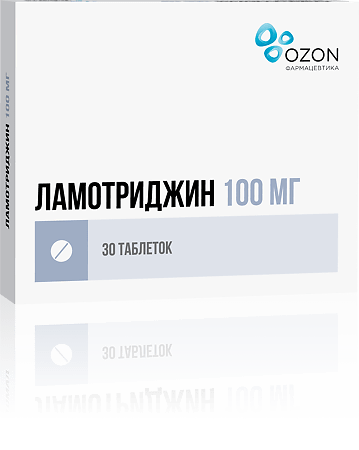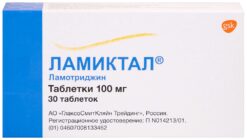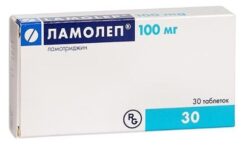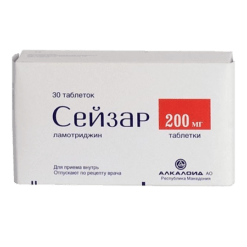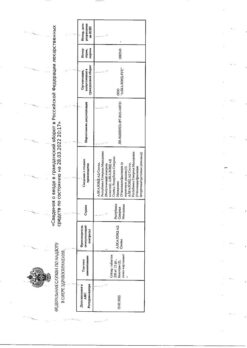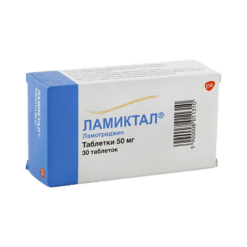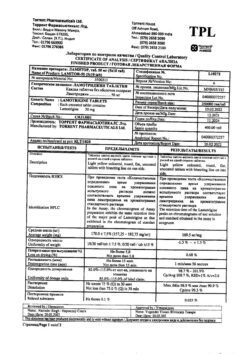No products in the cart.
Lamotrigine, tablets 100 mg 30 pcs
€28.28 €23.57
Description
An anticonvulsant agent. The mechanism of action is related to the effect on potential-dependent sodium channels of presynaptic membrane. This leads to decrease of mediators release into the synaptic cleft, first of all glutamate – excitatory amino acid, which plays an important role in the formation of epileptic discharges in the brain.
Indications
Indications
– partial and generalized tonic-clonic seizures (more often in cases of resistance to treatment with other anticonvulsants).
Pharmacological effect
Pharmacological effect
Anticonvulsant. The mechanism of action is associated with the effect on voltage-gated sodium channels of the presynaptic membrane. This leads to a decrease in the release of mediators into the synaptic cleft, primarily glutamate, an excitatory amino acid that plays an important role in the formation of epileptic discharges in the brain.
Special instructions
Special instructions
Use with caution in patients with renal failure.
Lamotrigine should not be used in elderly patients.
If severe allergic skin reactions occur, use of lamotrigine should be discontinued.
If lamotrigine is suddenly discontinued, the manifestations of epilepsy may increase, so it is necessary to gradually stop treatment, reducing the dose over 2 weeks.
When used simultaneously with carbamazepine, dizziness, diplopia, ataxia, visual impairment, and nausea are possible. These phenomena usually disappear when the dose of carbamazepine is reduced.
Lamotrigine should not be used in children under 2 years of age.
Impact on the ability to drive vehicles and machinery.
During the treatment period, a slowdown in the speed of psychomotor reactions is observed. This must be taken into account by persons engaged in potentially hazardous activities that require increased attention and rapid psychomotor reactions.
Active ingredient
Active ingredient
Lamotrigine
Composition
Composition
1 tablet contains
Active ingredient:
Lamotrigine 100 mg
Excipients:
Lactose monohydrate (milk sugar) – 167.8 mg
Microcrystalline cellulose – 76 mg
Povidone K-25 – 19 mg
Sodium carboxymethyl starch – 11.4 mg
Magnesium stearate – 3.8 mg
Colloidal silicon dioxide – 2 mg
Pregnancy
Pregnancy
Pregnancy
Clinical data on the safety of lamotrigine during pregnancy and lactation are insufficient.
When deciding whether to use it during pregnancy, the expected benefits of therapy for the mother should be weighed against the potential risk to the fetus.
Preliminary data indicate that lamotrigine is excreted in breast milk at concentrations that are 40-45% of plasma concentrations. A small number of infants whose mothers received lamotrigine did not experience any side effects.
Contraindications
Contraindications
– severe liver dysfunction;
– hypersensitivity to lamotrigine.
Side Effects
Side Effects
From the side of the central nervous system: headache, dizziness, drowsiness, sleep disturbances, feeling tired, aggressiveness, confusion.
From the digestive system: nausea, liver dysfunction.
From the hematopoietic system: leukopenia, thrombocytopenia.
Allergic reactions: skin rash (usually maculopapular), angioedema, Stevens-Johnson syndrome, toxic epidermal necrolysis, lymphadenopathy.
Interaction
Interaction
When used simultaneously with anticonvulsants – inducers of metabolism in the liver (including phenytoin, carbamazepine, phenobarbital, primidone), the metabolism of lamotrigine is accelerated. With the simultaneous use of lamotrigine and carbamazepine or phenytoin, the T1/2 of lamotrigine decreases.
There have been reports of dizziness, ataxia, diplopia, blurred vision and nausea in patients taking carbamazepine after starting treatment with lamotrigine.
Due to the inhibition of microsomal liver enzymes under the influence of sodium valproate, with simultaneous use the metabolism of lamotrigine slows down and T1/2 of lamotrigine increases.
Clinical pharmacology
Clinical pharmacology
After oral administration, lamotrigine is quickly and completely absorbed from the gastrointestinal tract. Cmax in plasma is reached after approximately 2.5 hours. Plasma protein binding is 55%.
It is subjected to intensive metabolism with the formation of the main metabolite N-glucuronide. T1/2 in adults averages 29 hours. It is excreted by the kidneys mainly in the form of a metabolite; about 8% of the active substance is excreted unchanged. T1/2 in children is less than in adults.
Manufacturer
Manufacturer
Ozon, Russia
Additional information
| Manufacturer | Ozon, Russia |
|---|---|
| Medication form | pills |
| Brand | Ozon |
Other forms…
Related products
Buy Lamotrigine, tablets 100 mg 30 pcs with delivery to USA, UK, Europe and over 120 other countries.

